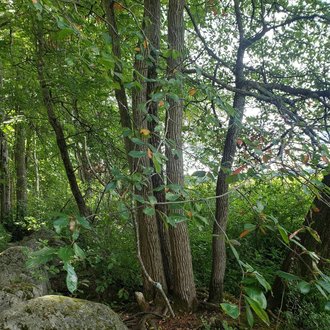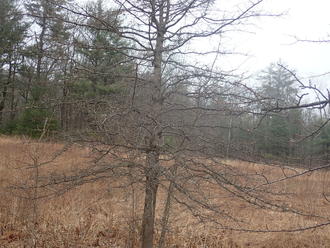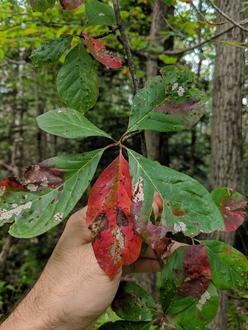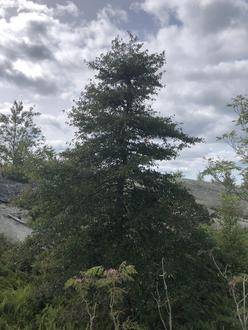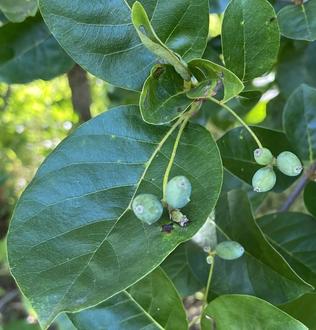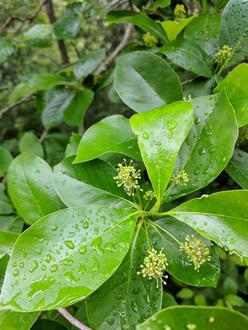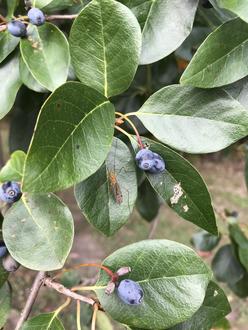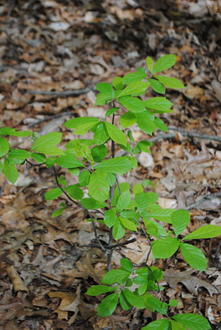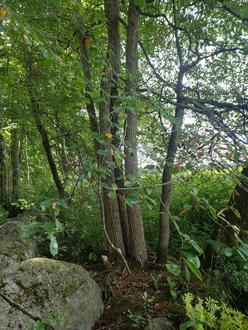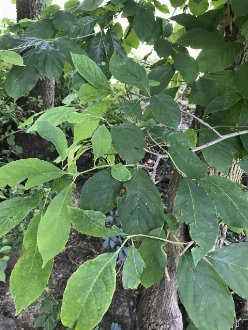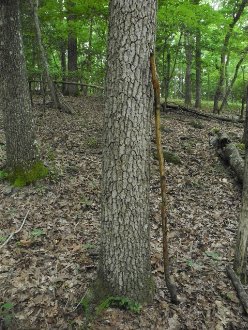Black Tupelo (Nyssa sylvatica Marshall)
Also known as black gum, blackgum, sour gum, tupelo, beetlebung; also classified as Nyssa silvatica (Misspelling).
↑Summary
A large, generalist tree of the eastern US and Ontario.
↑Range - Expand
| Legend | Color |
| Native | |
| Native or Not Present |
This tentative map is based on our own research. It may have limited data on Canada and/or Mexico, and there is some subjectivity in our assignment of plants as introduced vs. expanded. Read more in this blog post.
Although this plant occurs somewhere in each of these regions, it may only occur in a small part of some or all of them.
↑Similar Plants
↑Habitat
Nyssa sylvatica is a generalist found in a wide variety of habitats, including both forests and open sites, from dry uplands to moist bottomlands. In most of the habitats where it occurs, it is not dominant and occurs only as scattered individuals. Like many generalist species, it is more common on sites with some degree of adverse conditions that it tolerates better than other species.
Tolerates moist to dry-mesic conditions, but growth is best on moist sites; on dry sites it grows slower and reaches a smaller maximum size. It is less common on rich mesic sites due to competition from other species. Tolerates brief, but not prolonged spring flooding, and in bottomlands, is more common on low ridges and other locally-elevated areas. More common in swamps in the north of its range, where its more flood-tolerant relatives, swamp tupelo (Nyssa biflora) and water tupelo (Nyssa aquatica), are not present. In the south, where those species are also found, they replace this species on the wettest sites.
Tolerates a wide range of soil types, but is most common on ultisols, leached soils common in the southeastern US, and most specifically udults, which are ultisols low in organic matter. Prefers, but is not restricted to sites with acidic soils. Can be found on sites with a wide range of soil textures, growing best on silty to loamy soils, but also found on soils with significant sand, clay, or rock content. Intolerant of soil salinity, and absent from areas along coastal estuaries or exposed to salt spray.
Found in all successional stages of forests, although more likely to be absent from later stages of mesic forests. Especially in the north of its range, it is an early colonizer of fields and meadows. This species is among the most shade-tolerant of trees occurring on wetter or drier sites where the canopy is less dense, and can reproduce under a closed canopy on these sites, but it is less shade tolerant than species such as sugar maple, beech, or American holly which can dominate on rich mesic sites.
This species is tolerant of fire and can occur in habitats where fire occurs, even benefitting from fire, mostly when it grows on uplands. This fire tolerance distinguishes it from red maple (Acer rubrum), a fire-intolerant generalist tree with otherwise similar habitat preferences. Black tupelo however is absent from the most extreme fire-prone sites such as those dominated by pines and fire-tolerant oaks. It is most vulnerable to fires that occur early in the growing season.
Highly windfirm, and may benefit from hurricanes in the southeast.
Tolerates urban conditions, including soil compaction.
↑Life Cycle
Black tupelo is a long-lived tree.
Seeds germinate in spring following a period of cold dormancy. Large numbers of seedlings often establish on a site at once, following a disturbance that removes most vegetation. Seedlings are able to survive in a wide range of lighting conditions from full sun to under a closed canopy, and grow faster the more light is available to them. Seedlings or saplings growing in shade can persist for years, growing slowly until a gap appears, at which point they rapidly respond. Individuals growing with more light will demonstrate a more steady growth.
Most young trees quickly develop a taproot, although the structure of the root system varies considerably based on soil structure and aeration.
We have not found information on how long this species takes before first producing seed. However, seed production tends to be irregular from year-to-year. Trees flower in spring, after leaf-out, when the leaves are starting to reach their full size. The exact bloom timing varies greatly by climate, and can range from April to June. Trees are dioecious, meaning female and male flowers are borne on separate plants. Fruit ripens in early fall and is distributed by animals shortly after, with a small amount of fruit lingering up to a month after ripeness but not usually staying on the tree long-term, as the fruit tends to be one of the more attractive fruits to animals. A small portion of the leaves turn bold red about when the fruit ripens, well before the rest of the leaves change color, perhaps signaling ripeness to some animals more effectively than the dark blue color of the fruit itself.
Trees, especially younger ones, will resprout vigorously after being top-killed by fire or mechanical damage. Sprouts mature rapidly and may flower and fruit as soon as 2 years after such a disturbance. Under some circumstances, plants may reproduce vegetatively by sending up new stems from lateral roots. This species can also reproduce by layering, with buried portions of a branch growing roots, but layering rarely occurs in the wild.
Trees typically live 100-250 years and one individual has been recorded living to 679 years. Trees can be killed by a variety of causes, including heart rot following mechanical damage, by severe fire, or by prolonged flooding.
↑Faunal Associations
Young shoots early in the growing season are browsed by white-tailed deer; the foliage is mostly ignored later in the season. Stump sprouts represent the most valuable forage because of their ease of accessibility and vigorous growth.
The fruits are consumed by a wide variety of animals, including birds and mammals, and are highly nutritious to these animals due to their high fat content. These include fruit-eating birds such as the northern mockingbird, robin, brown thrasher, and wood thrush, but also larger birds such as the wood duck, wild turkey, and pileated woodpecker, as well as birds that do not normally eat fruit unless it has a high fat content, such as the Eurasian starling. Mammals eating the fruit include the gray and fox squirrells, gray fox, opposum, raccoon, and black bear.
The flowers are insect-pollinated and attract a wide variety of pollinators, although the details of which pollinators are attracted to this species have not been studied thoroughly. In addition to native pollinators, European honeybees also visit the flowers.
The foliage is eaten by a number of moth species, including the false underwing moth Allotria elonympha), which also eats hickories and walnuts, the tupelo leafminer moth (Antispila nysaefoliella), the Cadbury's lichen moth or Cadbury's Mystique (Comachara cadburyi or Polygrammate cadburyi), Hebrew moth (Polygrammate hebraeicum), azalea sphinx moth (Darapsa pholus) which primarily eats Azalea and Viburnum, and the forest tent caterpillar (Malacosoma disstria), and the alien probole (Probole alienaria).
Two species of plant bug (Miridae) specialize on this genus: Lygocoris nyssae and Lepidopsallus nyssae, and the aphid Aphis coreopsidis overwinters on this and other Nyssa, and then eats the stem and new shoots in early spring, leaving to eat other plants in the warm season.
The wood of dead or dying trees is eaten by the larvae of three species of long-horned beetles (Cerambycidae): Aegomorphus morrisi, Charisalia americana, and Trigonarthris proxima.
↑Uses
Black tupelo can be used to produce honey, but it is not used to produce the higher grades of "tupelo honey" that fetch the highest prices; the best honey comes from the Ogeechee tupelo (Nyssa ogeche), and the water tupelo (Nyssa aquatica) also is considered to produce superior honey. Honey produced from this species tends to be darker in color and crystalizes more easily, and is primarily used in baking.
This tree is sometimes planted in landscaping, where it is valued for its ability to thrive on most sites, including in urban conditions, and its bold red fall color, which appears on isolated leaves long before most trees start changing color. As a landscaping plant, it is underutilized. Its use in landscaping is likely limited by the fact that it is difficult to transplant. Unlike many trees, it only transplants well in the spring. Transplant stress can be avoided by waiting for a volunteer plant to come up in a desired spot, but if trees are transplanted, this move is best done when they are very young. Transplanting is also more difficult for trees grown on sites with deep soil, as they tend to develop a deeper taproot.
The wood is used for a variety of purposes, including veneer, flooring, crates and boxes, gunstocks, pistol grips, rollers in glass manufacturing, and occasionally as railroad ties, with lower-quality wood being used for pulp. It is easy to work with, particularly easy to carve, yet strong, and it holds fine details well, and also tends to be easy to paint, but it has a tendency to warp when drying, and has poor durability and be susceptible to rot as well as insect damage. Availability is spotty; when it is available it tends to be moderately-priced, although higher-quality blocks for carving are more expensive.
↑Related Plants
Four other Nyssa species are found in North America. Two of them, water tupelo (Nyssa aquatica) and swamp tupelo (Nyssa biflora), overlap significantly in range, but have smaller ranges primarily in the south of this species' range. The ogeechee tupelo (Nyssa ogeche) has a restricted range in a small region of the southeast, and the bear tupelo (Nyssa ursina) is rare and only found in a small area of the Florida panhandle.
Of these, this species is thought to be most closely related to swamp tupelo (N. biflora) and bear tupelo (N. ursina), which are closely related, after which it is next-most-closely related to N. japonica, which is not found in North America, followed by at least two other East Asian species, N. sinensis and N. yunnanensis, and less closely-related to water tupelo (N. aquatica) and N. ogeche, which are themselves closely related. There are presently no introduced Nyssa species established in the wild in North America.
There are no other plants in the Nyssaceae family found in North America, leaving the next-most-closely related plants to be others of the Cornales order, including the Cornaceae (dogwood) and Hydrangeaceae (hydrangea) family, and, in Western North America, the Loasaceae (stickleaf) family. Historically Nyssaceae was thought to be closest-related to Cornaceae but some newer genetic research has thrown this classification into question.
↑Links & External Resources
• Black Tupelo | The Wood Database (About This Site)
• Nyssa sylvatica (Black Tupelo) | Illinois Wildflowers (About This Site)
• Nyssa sylvatica (Tupelo) | USDA PLANTS Database (About This Site)
• Nyssa sylvatica | Go Botany (About This Site)
• Nyssa sylvatica (Black Gum) | Missouri Botanical Garden Plant Finder (About This Site)
• Blackgum | Virginia Tech Dendrology Factsheets (About This Site)
• Nyssa sylvatica | Biota of North America Project (BONAP) (About This Site)
• Black Tupelo | Silvics of North America (About This Site)
• Nyssa sylvatica, N. biflora | Fire Effects Information System (FEIS) (About This Site)
• Nyssa sylvatica | NatureServe Explorer (About This Site)
• Nyssa sylvatica | Flora of North America (About This Site)
• Black Gum | Maryland Biodiversity Project (About This Site)
• Nyssa sylvatica Marshall (Black Gum, Sour Gum) | Digital Atlas of the Virginia Flora (About This Site)



